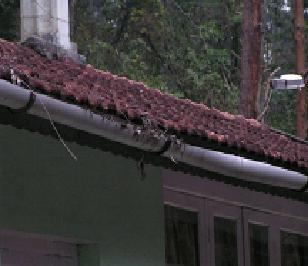Gutters are pipes around the edge of the roof (usually sloped roofs) that collect and transport rainwater from the roof. Downtake pipes are cylindrical pipes that transport the water down, directly from the roof or from the gutters, until the storage tank.
Gutter shapes and materials
Gutters implemented for sloped roofs can be of different shapes
semi circular ‘U’ Shape Rectangular Trapezoidal 'V' Shape
The semicircular and trapezoidal shaped gutters offer least resistance and result in optimum flow. Their wider mouth reduces wastage of water by splashing. Semi circular gutters are usually preferred since other shapes are not easily available and this one can be easily created by slicing a PVC cylindrical pipe in half. Rectangular, trapezoidal and V shape gutters are usually made from Zinc sheets.
Common material for downtake pipes are ultra-violet treated Poly Vinyl Chloride (PVC), Galvanized Iron (GI), Cast Iron and asbestos cement. Downtake pipes will be present in most buildings, leading rainwater to the ground. Older constructions would have asbestos cement pipes but more recent ones would have PVC, and in a few cases GI downtake pipes. PVC pipes are preferred since they are
- lightweight
- cost effective
- do not rust
- are easy to procure, install and repair and
- allow for increased flow rates because they are smoother than their metal counterparts
It is advised to use IS Quality pipes.
Figure 4.1: Different methods of fixing gutters to walls
Installation of gutters and downpipes
Installation of gutters and downtake pipes is very important.
- At the inlet to a downtake pipe from the roof surface, a wire mesh screen or grating may be present to keep out leaves and other debris. It is recommended that these screens and gratings be installed only if the rooftop is cleaned regularly. Otherwise there are chances of leaves and other debris clogging the grating and water stagnation on the rooftop. If grating is not present, the filter must be able to handle the debris that comes down from the rooftop.

Figure 4.2: A gutter clogged with leaves and other debris
- Gutters must slope towards the downtake pipe, so that there is no water stagnation. A slope of 1/16 inch per foot to 1/8 inch per foot in the direction of the nearest vertical downtake pipe is recommended .
Figure 4.3: Different ways of fixing gutters to downtake pipes
- Gutters need to be well supported so that they do not sag or get dislodged during heavy rains. Good quality U or L clamps must be used for the same and the gutters should be clamped to the wall every two to three feet to prevent damage during heavy rains. Improperly fixed clamps can cause sagging gutters leading to water stagnation and leakages. Water leaks can then spread to the building walls as well.
Figure 4.4: Inadequate support leading to dislodged gutter
- To save on piping costs, flat roof catchment discharge points can be linked by a horizontal downtake pipe running just below the roof, instead of bringing downtake pipes from the roof to the ground at each discharge point and linking them at the bottom. A vertical downtake pipe common to three or four discharge points can be led downwards. A similar slope and clamping as recommended for gutters should be implemented in this case as well.
- Vertical downtake pipes need to be clamped to the wall using U clamps / brackets.
- For long sloped roofs, splash guards on gutters are useful to prevent wastage of water.
- A gutter or downtake pipe should not be run horizontally for more than 60 ft. without a vertical downtake pipe.
- Many buildings may have grooves and extensions for architectural aesthetics. Since it is not advisable to introduce a large number of bends to lead the pipes along these grooves and extensions, L angles may be used to clamp the pipes at a distance from the wall.
Figure 4.6: Use of L angles to fix gutters and downtake pipes
- It is advised that lead based sealants not be used to join gutters and downtake pipes.
- All metal components used to fix the gutters and downtake pipes (clamps, angles etc.) should be properly painted after a protective coat of primer. This will ensure that they do not rust and give way.
Sizing of rainwater downtake pipes for roof drainage
- The diameter of the downtake pipes varies depending on the roof area to be drained and the peak intensity of rainfall. A bell mouth inlet at the roof surface is found to give a better drainage effect.
- Gutters should preferably be smaller or the same size as the downtake pipes, depending on the number of gutters that lead into one downtake pipe.
Source: Rainwater Harvesting - Trainers’ Manual published by Karnataka Urban Infrastructure Development and Finance Corporation
